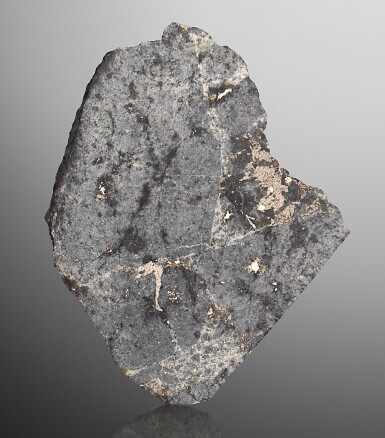Natural History
Natural History

Ensisheim Meteorite — The Meteorite Which Discovered Earth In 1492
No reserve
Lot Closed
December 3, 08:56 PM GMT
Estimate
3,000 - 4,000 USD
Lot Details
Description
Ensisheim — The Meteorite Which Discovered Earth In 1492
Amphoterite, LL6
Alsace, France
66 x 52 x 1mm (2.5 x 2 x 0.1 in.) and 10.27 grams (51 carats)
Ensisheim is among the most historic of all meteorites. It is not only the oldest European witnessed fall, but also Europe’s heaviest at 127 kilograms (279 pounds). Samples are extremely difficult to obtain and are typically deaccessioned from museums in exchanges for which the museum receives something extraordinary in return — which was the case here.
Shortly after Ensisheim fell on November 7, 1492, the stone was brought into the walled city of Ensisheim and tethered to a chain in a dungeon in an effort to prevent it from departing the same way it had arrived. A 16th Century document describes the descent.
“In the year of Our Lord 1492, the Wednesday before the feast day of Saint-Martin, the seventh day of November, a strange miracle occurred. On that day, between the eleventh and the twelfth hour of noon, came a great thunder clap, then a long noise that was heard far around, then a stone fell from the air on the village of Ensisheim. It was surely a sign from God, such as had never been seen before, or read or written about.” Austria’s Emperor Maximillian is said to have divined that the fireball was a sign for him to declare war on France — which turned out well as he captured new territory and his daughter — who had taken up with the French King.
Had this meteorite fallen in parts of Spain, the witness to the event may have been put to death as the notion that rocks could fall out of the sky at this time was considered heresy in some parts of the world. In fact, the extraterrestrial origin of meteorites did not gain wide acceptance until 300 years after the Ensisheim phenomenon, from which is now offered this spectacular partial slice featuring Ensisheim’s characteristic fine blue-gray brecciated matrix with a large inclusions of iron sulfide and iron nickel that originated from the core of an asteroid.
PROVENANCE:
The Natural History Museum, London
Macovich Collection of Meteorites, New York City
